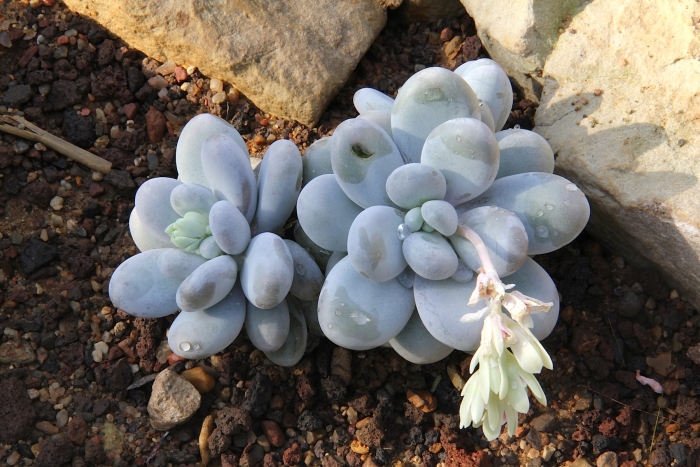Moonstones
(Pachyphytum oviferum)
Moonstones (Pachyphytum oviferum)
/
/

Peter A. Mansfeld
CC BY 3.0
Image By:
Peter A. Mansfeld
Recorded By:
Copyright:
CC BY 3.0
Copyright Notice:
Photo by: Peter A. Mansfeld | License Type: CC BY 3.0 | License URL: https://creativecommons.org/licenses/by/3.0 | Uploader: PeterMansfeld | Publisher: Wikimedia Commons | Title: Pachyphytum_oviferum_pm.JPG | Notes: {{Information |Description=''Packera paupercula'' |Source=[http://picasaweb.google.com/pelserpb/SenecioneaePhotoGallery National Science Foundation under Grant No. 0542238] |Date=May 21, 2006 |Author=NSF Photographer |Permission={{PD-USGov-NSF}} |other_ve |






























Estimated Native Range
Summary
Pachyphytum oviferum, commonly known as Moonstones, is an evergreen succulent plant native to rocky outcrops and cliffs in the semi-desert regions of Northeast Mexico. This species is characterized by its distinctive, egg-shaped leaves that are pale blue-green to bluish-purple, resembling sugared almonds. The fleshy leaves are 3 to 5 cm long, 1.8 to 3 cm wide, and 8 to 17 mm thick, arranged in rosettes. Moonstones typically produce stems that are about 20 cm long and 1 cm thick, which initially grow upright but then arch over as they lengthen. The inflorescence is a 30 cm stem bearing showy, scarlet, bell-shaped flowers that add a splash of color when they bloom.
Moonstones are valued for their unique, ornamental foliage and low-maintenance requirements, making them ideal for rock gardens, container plantings, and as houseplants. They thrive in full sun, requiring very low to low water once established, and prefer well-draining soils. While they are drought-tolerant, they are sensitive to overwatering, which can lead to root rot. Moonstones are not known for aggressive roots or significant disease issues, but they can be susceptible to mealybugs and fungal diseases if kept in overly moist conditions. To prevent these problems, it is crucial to allow the soil to dry out between waterings and provide adequate air circulation.CC BY-SA 4.0
Moonstones are valued for their unique, ornamental foliage and low-maintenance requirements, making them ideal for rock gardens, container plantings, and as houseplants. They thrive in full sun, requiring very low to low water once established, and prefer well-draining soils. While they are drought-tolerant, they are sensitive to overwatering, which can lead to root rot. Moonstones are not known for aggressive roots or significant disease issues, but they can be susceptible to mealybugs and fungal diseases if kept in overly moist conditions. To prevent these problems, it is crucial to allow the soil to dry out between waterings and provide adequate air circulation.CC BY-SA 4.0
Plant Description
- Plant Type: Succulent
- Height: 0.3-0.4 feet
- Width: 0.8-1 feet
- Growth Rate: Slow
- Flower Color: White, Red
- Flowering Season: Winter, Spring
- Leaf Retention: Evergreen
Growth Requirements
- Sun: Full Sun
- Water: Very Low, Low
- Drainage: Medium, Fast
Common Uses
Border Plant, Drought Tolerant, Low Maintenance, Potted Plant, Rock Garden
Natural Habitat
Rocky outcrops and cliffs in the semi-desert regions of Northeast Mexico
Other Names
Common Names: Sugaralmond Plant, Sockermandlar
Scientific Names: , Pachyphytum oviferum,
GBIF Accepted Name: Pachyphytum oviferum J.A.Purpus